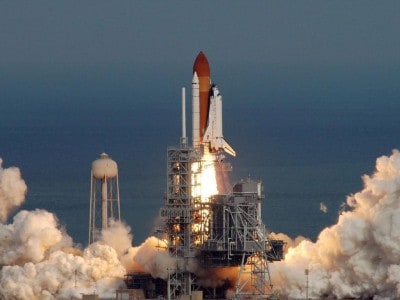
Europe’s Columbus laboratory has been successfully launched into space towards its eventual home on the International Space Station (ISS). The 10-tonne Columbus module took off on board the space shuttle Atlantis as it lifted off from the Kennedy Space Center in Cape Canaveral, Florida, at about 14:50 EST (19:50 GMT) today. American and European astronauts will spend the next 11 days connecting the module to the space station, in what will be the single largest contribution by the European Space Agency (ESA) to this international effort.
Columbus is a 4.5 m-wide cylindrical space capsule that has room for 14 separate science experiments. The lab will primarily study how reduced gravity affects a range of medical and physical phenomena.
“I think it is very important for Europe to have a permanent laboratory up there,” says Martin Zell, ESA’s head of research operations in human spaceflight, microgravity and exploration.
The €700m laboratory is a user facility containing 10 telephone-booth-sized racks that can accommodate a wide range of experiments over Columbus’s proposed 10-year lifetime. “A satellite mission is fixed from the beginning, whereas in Columbus the facilities host experiments that can change,” says Zell. Five of the racks have been pre-installed in Columbus before launch with experiments to study fluid science, biology and physiology.
The shuttle Atlantis also contains two separate payloads — a suite of solar observation equipment and a material testing platform — that astronauts will hook up to two of Columbus’ four external mountings that are exposed to outer space. “Columbus is more than a science laboratory; it is a technology test bed that will give Europe experience in living in space,” Zell says.
I think it is very important for Europe to have a permanent laboratory up there Martin Zell, ESA
Physics experiments
Several physics experiments will take place in the Fluid Science Laboratory (FSL), which includes various interferometers and high-speed cameras for studying user-provided liquids, emulsions and aqueous foams in the station’s microgravity. The first FSL experiment is Geoflow, which will model the dynamic flow in the Earth’s liquid mantle by trapping silicon oil between two concentric spherical shells. Simulating the mantle is extremely difficult on the Earth’s surface because gravity overwhelms the other forces that are of interest. “Columbus provides us the opportunity to study the influences of temperature and rotation on convective flow when gravity is no longer there,” says Geoflow team member Birgit Futterer of Brandenburg Technical University in Cottbus, Germany.
The launch, originally planned for early December last year, was twice called off due to a glitch in a now-repaired fuel gauge sensor. This final hold-up capped a 16-year delay, as the Columbus lab was due to lift-off in 1992 to commemorate the 500th anniversary of its namesake’s voyage to America. However, it was not until 1995 that ESA decided on the lab’s full development and not until 2002 that much of the construction was completed in Italy and Germany. The Columbia shuttle disaster in 2003, in which seven astronauts died, put all plans on hold.
Geoflow had been scheduled to start just as soon as Columbus was secured to the station but with the two-month delay mission planners have moved ahead some biology experiments that are more time-sensitive. After such a long wait, both European and American scientists are anxious for Columbus to get going. “It is a huge enhancement in the research capabilities of the space station,” says Zell.



